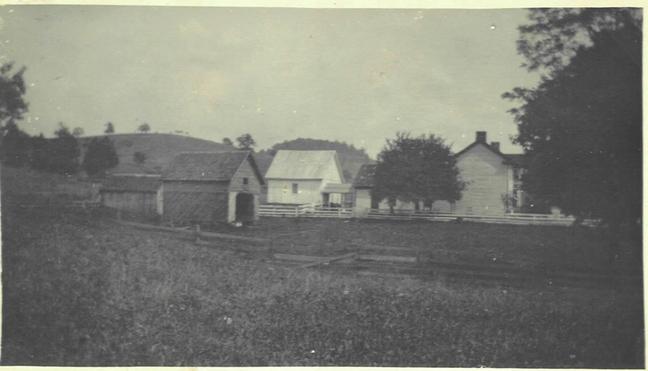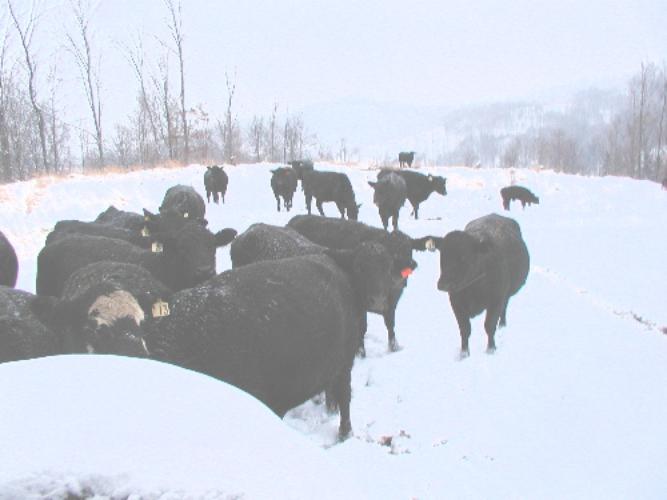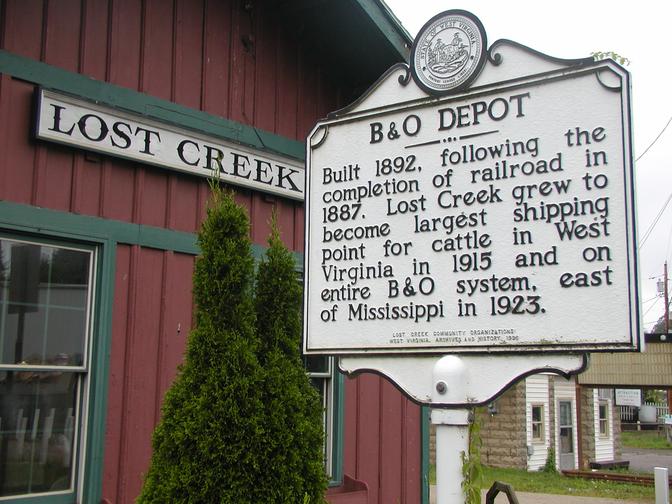
| Next Chapter | Previous Chapter | |
| Chapter 28: Clothing | Contents | Chapter 26: Nostalgia: 2. Blackberries |
The farm at Lost Creek was owned by a Thomas Bond, one of the Quiet Dell Bonds, I believe, before the two Van Horn generations that owned it. The Quiet Dell Bonds were good business people, coming from Maryland to West Virginia with money and making more in the milling business. They were descendants of Able Bond, a younger brother, we of Richard Bond, and both came West in 1799 with their father, Richard Clayton Bond. The Quiet Dell line had only one living representative in this area that I knew, Kale Bond, who died while this book was being written.
(Illustration 27-1)

The old house at the Lost Creek farm. It had the same floor plan as our house at Jesse Run. Note the granary like the one at Jesse Run and the attached quarters at the rear of the house. The knob at the left rear has been flattened by striping.
Winters were surely colder than they are now before Grandfather bought the Lost Creek farm. Aunt Lotta told me there was a ice house in the corner of the property where the sewage pump station now stands. I think this was before her time, before the farm came into our family. They would cut ice on the creek in front of the house with special saws. The creek was quite wide, and large chunks were drawn out with horses. They cut the ice in pieces that could be lifted into an ice box easily, and stacked it in the ice house. The insulation was saw dust. It was in the walls, and was used to separate the pieces so they wouldn't freeze together. (This is all hearsay, the icehouse was gone before my time, possibly before Aunt Lotta's.)
Grandma Bond had an icebox on her back porch long after the refrigerator came into the house. It was about shoulder high, three feet wide and two deep, painted green. The upper compartment was for food, about one-third of the volume, and the lower for ice. Both were lined with galvanized metal. At the bottom there was a board hinged to swing from the top. You slid a pan behind the door to catch the melt from the ice, and it had to be emptied regularly, or the floor flooded. It was not homemade. In my time it served as a cupboard for odds and ends.
An old sawmill sat behind the barn on a little rise, in the middle of the orchard mentioned above. Dad remembered it. There was a large pile of sawdust that just rotted away. Pictures of the hill taken when the old house was still in existence (that is, before 1932) show the hill pretty well cleared.
The hill was mined shortly after WWI by the Hutchinson Coal Company. This was a very large company with principal offices in Fairmont, New York and Cincinnati. Hutchinson had several mines but the mine opening for coal taken out under the Lost Creek farm was in Hutchinson Hollow, at Mount Clare. There was at least one other mine owned by the same company in Mount Clare, in Florence Hollow.
The coal was cut out by pick, then loaded on coal cars by shovel. The cars were pulled to Mount Clare by mules, and there the coal was loaded on train cars. Most of the workers were immigrants, many Italian. Huge pillars were left in our hill, which made recovery feasible in the late 1990s. My mother, sisters and I were the beneficiaries of this recovery, which was done by United Coals.
(Illustration 27-2)

Cattle in winter
Ralph Sutton, the Vice-President, showed me the map of the mine made by Hutchinson. It was beautiful, and Ralph said it was very accurate. It was on a huge paper backed by burlap five feet by about twenty feet. The scale was one inch to one hundred feet, and the lettering is elegant. Hutchinson kept two men at work full time to plot the progress of the mine.
The hills were seriously eroded when my grandfather bought the farm because corn had been planted on steep hillsides, with rows up and down the slope. There apparently had been a house on the Northeast corner of the farm some time in the past. This I deduce from the lay of the land and the greater erosion in that area.
The highest point on the farm is the highest anywhere around. It was always called "Van Horn Knob" in my youth. Aunt Lotta told me that she and Dad liked to go up there and look back toward the area they knew on Hacker's Creek. They could identify Bear Knob on their grandfather's farm (Booth Bond's farm) by a "snag," or dead tree, that stood on it. Bear Knob is located in Warren District of Upshur County. It is marked on topo maps, almost 1900 feet high.
I know little about the farm where I now live on Jesse Hughes Run except what I have found out about it from searching the Courthouse records. It was owned before us by S. O. Bond and Carroll Bond and their wives. They raised very fine purebred Hereford cattle. Before them, the farm was owned by a physician, Dr. Fleming Howell, of Buckhannon, and his wife Gertrude. She was a member of the very wealthy Bennett family of Lewis County, and he was something of a high flier, a risk taker.
Howell had put the two large tracts in the farm together; on the East from Abraham Holbert and on the West from Capt. M. T. Smith. Smith's house had burned. The site of his house is along the hard road, just to the right of our coal road. The bricks are still there, although many have been carried away. They were probably made in Jane Lew at the brick factory. The Smith farm was part of an earlier farm that belonged to a Prestly McIntyre. His second wife (and possibly other family members) are buried in the cemetery on the little ridge that lies above the last gully on the West end of the farm. The McIntyre farm included land to the south and West, what became the Ray and Betty Smith farm in our time.
(Illustration 27-3)

Historical marker in Lost Creek commemorating the cattle industry of bygone days
Unquestionably, the oldest thing I know about on either farm is the "stonepot" on the Jesse Run farm. I was introduced to it by Danny Collins, who called it the "Indian Spring." It lies in the bend of the coal road, by a big Beech tree. There is a shelf of rock that projects out with a nearly horizontal surface. Water seeps out over the rock. Here the Indians made a depression about the size of half a basket ball, apparently by pounding the rock surface with another rock. It fills up with water and the depression is just right to dip out water with a gourd. Carroll Bond said the spring never goes dry.
The area across the coal road from the stonepot, which we call the "coal road meadow," was plowed by my predecessor, Carroll Bond, to plant corn. They turned up many arrowheads, which he thought validated the tradition it was an Indian camp ground.
The deep coal on the Jesse Run farm was mined between 1921 and sometime in the early thirties by a much smaller company than the Hutchinson company. They took the coal out on the other side of the hill. There was a siding that ran up the valley behind Jack and Thelma Shock's house. The opening was below the little point that lies below higher hills, next to the pond.
There were at least four bankruptcies in the history of the Jesse Run farm. If we had known it, that would have been pretty scary in the early days when things were so thin financially. It's just history in this generation, but who knows what will happen in the future?
Aside Bob Mendez was a good friend and a very hard worker who knew many people. He was descended from a family that came from Castile (Northern Spain) to work in the zinc industry. Three stories he liked to tell follow.
A fellow in Fairmont asked him to grow marijuana. This was the deal the fellow offered: Bob would grow it, dry it, and use his bailer to make a square bale. Then the fellow would pay him $1000 (in the 1970's) for it, and give him the seeds for free. Of course Bob's answer was "No deal!"
Bob was as smart as any college professor I have known (and I have know quite a few). He knew more than most, but was, I believe, somewhat embarrassed by not having a college education. He was a coal miner at night and worked his way up to electrician. He said the electrician on duty in a coal mine could crawl up onto the motor (which pulls the coal cars out of the mine), which was warm, when he was not needed and go to sleep. He got paid the same. Bob worked the night shift and farmed in the daytime.
The place where his extended family lived in Spain was on the north shore, where he could look down from the heights on the Bay of Biscay. The family sent him to visit the Spanish relatives in the 30s when he was a little boy, and he got caught for a while in the Spanish Civil War. Franco was fighting the Communists, and Hitler sent military assistance to Franco. Bob said he could remember the dive bombers sweeping down on the nearby town. He said there never was a kid that wanted to go home worse than he did!
| Next Chapter | Previous Chapter | |
| Chapter 28: Clothing | Contents | Chapter 26: Nostalgia: 2. Blackberries |
Copyright © 1998, 2006, 2008, 2011 S. Tom Bond (stombond at hughes.net)